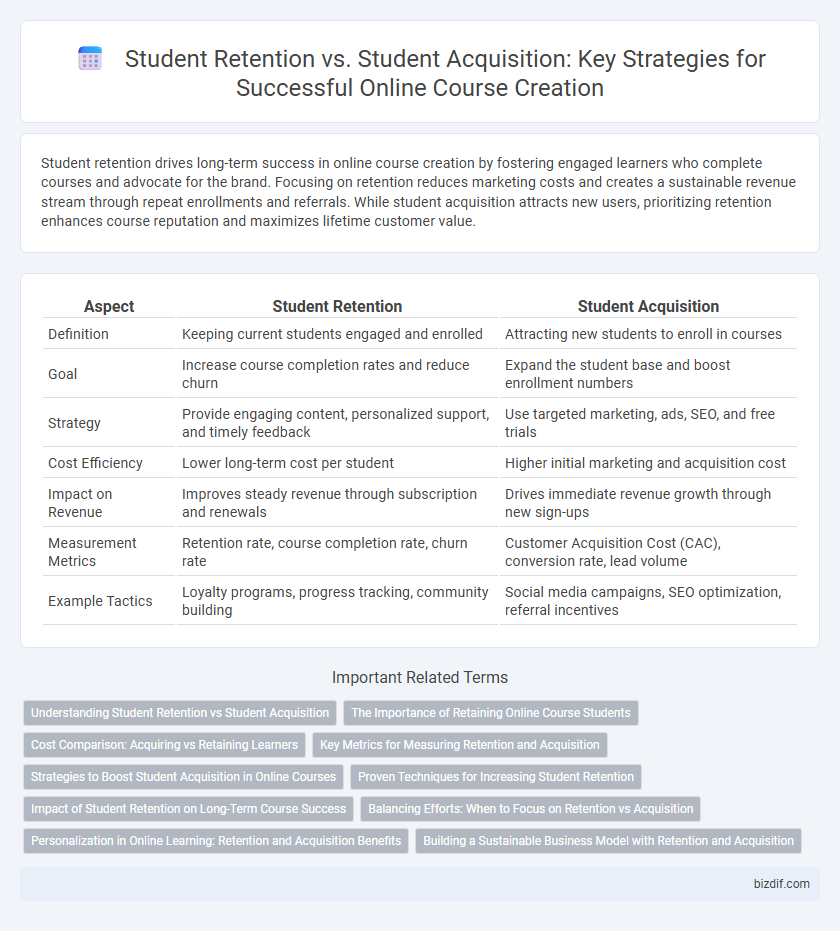Student retention drives long-term success in online course creation by fostering engaged learners who complete courses and advocate for the brand. Focusing on retention reduces marketing costs and creates a sustainable revenue stream through repeat enrollments and referrals. While student acquisition attracts new users, prioritizing retention enhances course reputation and maximizes lifetime customer value.
Table of Comparison
| Aspect | Student Retention | Student Acquisition |
|---|---|---|
| Definition | Keeping current students engaged and enrolled | Attracting new students to enroll in courses |
| Goal | Increase course completion rates and reduce churn | Expand the student base and boost enrollment numbers |
| Strategy | Provide engaging content, personalized support, and timely feedback | Use targeted marketing, ads, SEO, and free trials |
| Cost Efficiency | Lower long-term cost per student | Higher initial marketing and acquisition cost |
| Impact on Revenue | Improves steady revenue through subscription and renewals | Drives immediate revenue growth through new sign-ups |
| Measurement Metrics | Retention rate, course completion rate, churn rate | Customer Acquisition Cost (CAC), conversion rate, lead volume |
| Example Tactics | Loyalty programs, progress tracking, community building | Social media campaigns, SEO optimization, referral incentives |
Understanding Student Retention vs Student Acquisition
Student retention measures how effectively an online course keeps learners engaged and enrolled over time, directly impacting long-term revenue and community strength. Student acquisition focuses on attracting new learners through marketing strategies such as social media campaigns, search engine optimization, and partnerships. Balancing retention and acquisition is crucial for sustainable growth, as retaining students often leads to higher lifetime value compared to solely acquiring new ones.
The Importance of Retaining Online Course Students
Student retention in online course creation directly impacts long-term revenue by reducing marketing costs associated with acquiring new students. High retention rates indicate effective course engagement and satisfaction, which drive positive reviews and organic growth. Prioritizing retention strategies such as personalized feedback, community building, and continuous content updates enhances student commitment and lifetime value.
Cost Comparison: Acquiring vs Retaining Learners
Acquiring new students often involves higher marketing expenses, averaging 5 to 7 times more than retaining existing learners, due to paid ads, promotions, and onboarding efforts. Retention strategies, such as personalized content and engagement tools, typically reduce churn rates and increase lifetime value, lowering overall costs per student. Investing in retention can yield more sustainable revenue streams by maximizing the value of the current student base while minimizing ongoing acquisition budgets.
Key Metrics for Measuring Retention and Acquisition
Student retention in online courses is measured by metrics such as course completion rates, active engagement levels, and recurring enrollment percentages, which directly indicate learner satisfaction and content relevance. Student acquisition focuses on tracking conversion rates from website visits to enrollments, cost per acquisition (CPA), and lead generation quality to evaluate marketing effectiveness. Prioritizing these key metrics helps course creators optimize strategies for sustained growth and improved learner outcomes.
Strategies to Boost Student Acquisition in Online Courses
Effective strategies to boost student acquisition in online courses include targeted digital marketing campaigns, such as pay-per-click advertising and social media promotions, which increase visibility among prospective learners. Offering free trial modules or introductory webinars engages potential students, providing a risk-free glimpse of the course content and teaching style. Optimizing course landing pages with clear calls to action, compelling testimonials, and user-friendly enrollment processes significantly enhances conversion rates and attracts a larger student base.
Proven Techniques for Increasing Student Retention
Proven techniques for increasing student retention in online course creation include personalized learning paths, interactive content, and regular feedback mechanisms that enhance engagement and comprehension. Leveraging data analytics to identify at-risk students enables timely interventions, improving course completion rates significantly. Implementing community-building strategies such as discussion forums and group projects fosters a supportive learning environment, further boosting retention and long-term success.
Impact of Student Retention on Long-Term Course Success
Student retention in online course creation significantly influences long-term course success by fostering continuous engagement, boosting completion rates, and generating positive word-of-mouth referrals. Higher retention rates increase lifetime student value, reducing the need for constant student acquisition expenses and enhancing overall profitability. Maintaining strong retention through personalized content and community support creates a sustainable learning ecosystem that drives ongoing growth and credibility.
Balancing Efforts: When to Focus on Retention vs Acquisition
Balancing efforts between student retention and acquisition is essential for sustainable growth in online course creation, with retention often yielding higher lifetime value per student. Invest in retention strategies like personalized learning paths and community engagement when your course has stable enrollment but lower completion rates. Shift focus to acquisition by leveraging targeted marketing and free trial offers when launching new courses or entering competitive markets to build a larger student base.
Personalization in Online Learning: Retention and Acquisition Benefits
Personalization in online learning significantly enhances student retention by tailoring content to individual learning styles and pacing, which increases engagement and reduces dropout rates. This targeted approach also improves student acquisition by attracting learners seeking customized educational experiences that meet their specific needs. Data-driven personalization tools enable course creators to optimize both retention and acquisition metrics, leading to sustainable growth in online course enrollments.
Building a Sustainable Business Model with Retention and Acquisition
Focusing on student retention ensures steady revenue through repeat engagement and higher lifetime value, while effective student acquisition drives growth by expanding the customer base. Balancing both strategies creates a sustainable online course business model that maximizes profitability and long-term success. Optimizing retention metrics such as course completion rates and engagement, alongside targeted acquisition campaigns, strengthens brand loyalty and market reach.
Student retention vs Student acquisition Infographic

 bizdif.com
bizdif.com